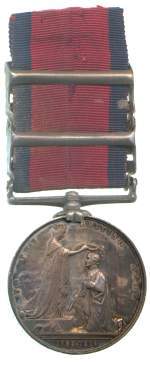Current Location: In storage
Maker(s)
Mint:
London
Ruler:
Victoria (1837-1901)
Artist:
Wyon, William
Ruler:
Victoria regina
(With the title of)
Entities
Categories
Description
It had been unusual, before the reign of Queen Victoria, for medals to be issued recognising service in campaigns (except perhaps those organised by the East India Company). This left, for example, veterans of the Napoleonic Wars with nothing to display for their service, and therefore three medals were instituted in 1847-1848 for campaigns of the previous fifty years, in the East India Company's forces, in the Royal Navy or in the Army, the last of which was the Military General Service Medal, instituted in 1847 and first struck in 1848.
The intentions of the medal committee are hard to divine, as the medal was struck carrying the dates `1793-1814' in the reverse, but the earliest campaign considered was that in Egypt from 1798 to 1801. Earlier battles may have been deleted from consideration due to the shortage of surviving veterans of engagements of the previous century. This was one of the paradoxes shared by all three of the General Service Medals, another being that the monarch whose portrait they bore, Queen Victoria, was not him for whom the recipients had fought.
The MGSM, given the period that it covered, was mainly awarded for campaigns of the Napoleonic Wars, which on land had mostly been fought in the Iberian Peninsula. For this reason the medal is often called the `Peninsular Medal' even though it also covered campaigns in Egypt, Java and America.
The Peninsular War arose from Emperor Napoleon I of France combining with Spain to occupy ports on the western coast of Portugal, in order to break the British naval blockade of France in 1807, which he followed in 1808 by a military takeover of Spain. Spanish resistance forces administered several defeats to occupying French forces, however, and this and a concomitant Portuguese uprising persuaded Britain to commit land forces against Napoleon for the first time in some years, under Sir Arthur Wellesley, the later Duke of Wellington (who is seen on the reverse of the MGSM).
Campaigning began in 1808 and was heroic but inconsistent, with victories in the field to both sides. The first battle that Wellesley fought was at Roliça in August 1808, where he outnumbered the French three-to-one; victory was unsurprisingly British, and four days later a French counter-attack at Vimeiro was equally convincingly defeated.
The Allied campaigning was dogged by disagreements between Spanish and British authorities. The Spanish were unable to supply the British with the provisions they required, despite promises to do so; the Spanish in turn bitterly resented the plundering to which hungry British troops resorted. This bitterness began to affect battlefield collaborations, meaning that potentially decisive victories were several times fumbled. By 1810 Wellesley was fighting without Spanish support wherever possible, defeating a French reinforcement force under Maréchal Masséna at Buçaco in September 1810 and driving it out of Spain entirely in May 1811.
By early 1812, largely due to widespread Spanish guerilla attacks tying down their forces, the French were unable to match their opponents in the field. In July of that year Wellesley, leading Spanish, Portuguese and British forces, "defeated an army of 40,000 men in 40 minutes" at Salamanca and briefly liberated Madrid. In May 1813 he followed this up with a similar defeat of King Joseph Bonaparte himself at Vittoria, sacking the French-held fortress of St Sebastian in the subsequent pursuit of the fleeing French.
This medal is inscribed to Private Joseph Weller of the 9th Foot, otherwise known as the Norfolk Regiment. To judge by the bars it carries he fought at the two 1808 battles mentioned above, and appears to have returned to campaigning in 1810 in time for the others here described, perhaps having been wounded in the meantime. The award of the medal to him is not however confirmed in official records. Lester Watson acquired it at some point before 1928.
Notes
History note: Gift of L. Hoyt Watson; ex Lester Watson Collection, acquired before 1928
Legal notes
Given by Lester Watson through Cambridge in America, 2009
Measurements and weight
Diameter: 36.2 mm
Weight: 41.07 g
Acquisition and important dates
Method of acquisition: Given
(2009)
by
Watson, Lester
Dating
1848
-
1850
Materials used in production
Silver
Techniques used in production
Struck
Inscription or legends present
Inscription present: Bust of Victoria facing left
- Text: VICTORIA REGINA
- Location: Obverse
- Type: Design
Inscription present: Victoria on dais placing wreath on head of kneeling Duke of Wellington
- Location: Reverse
- Type: Design
References and bibliographic entries
Identification numbers
Accession number: CM.1333-2009
Primary reference Number: 141427
Watson Catalogue: 239
Ordering: M-0216
Previous object number: LW.0216
Stable URI
Audit data
Created: Saturday 6 August 2011
Updated: Monday 25 March 2024
Last processed: Wednesday 14 May 2025
Associated departments & institutions
Owner or interested party:
The Fitzwilliam Museum
Associated department:
Coins and Medals





